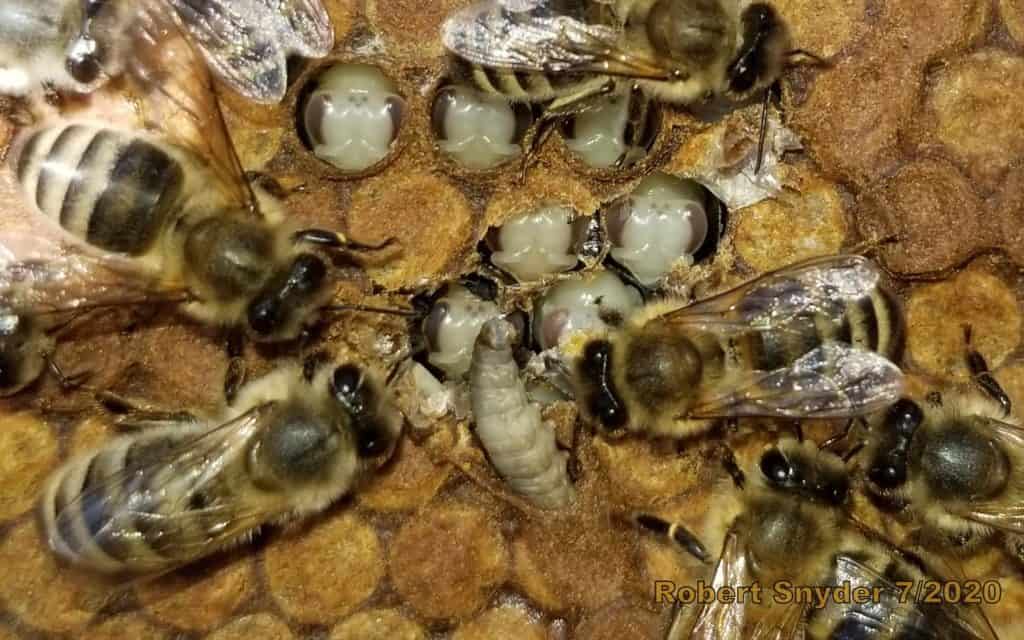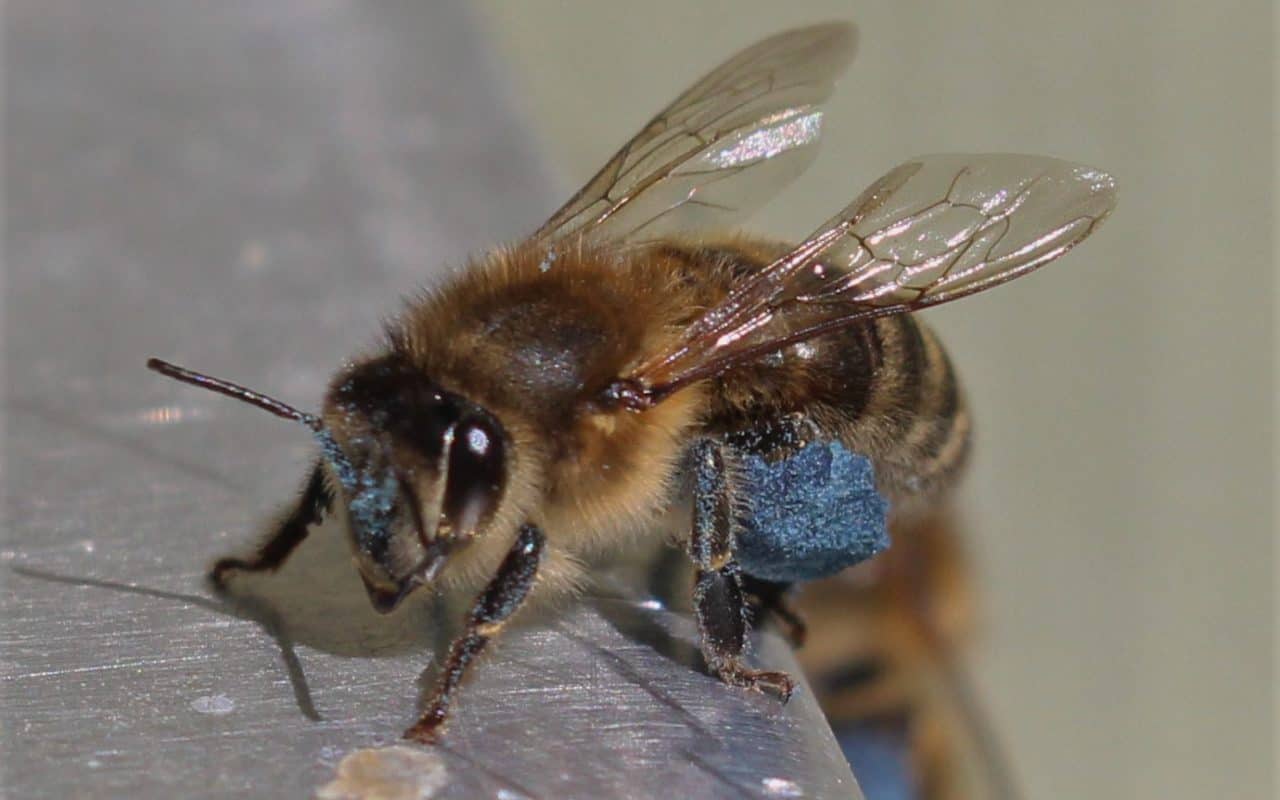One of the queen producers I work with, Joy Pendall, recently told me of some pest and flea problems she'd been having in a few of her yards. When she first told me about the damage these critters were causing I couldn't believe it - these mammals are not usually much of a pest for beekeepers to contend with, aside from occasionally chewing on the edges of bee boxes to wear down their constantly growing teeth. But Joy and her crew's stories and photos showed what an impressive amount of destruction that these little varmints managed to accomplish. The pictures (shared in this blog) show…
Category: Fun Facts
Detecting Wax Moth Larvae in Frames of Sealed Brood
As a honeybee health field specialist, when I am assessing a colony's health I look for irregularities in the sealed or open brood (Image 1 & 2). These irregularities may indicate the presence of diseases or pests. One common pest that can cause brood irregularities is the wax moth. Wax moth larvae develop underneath the honey bee colony's brood cappings. The wax moth larvae often bind a honey bee pupa’s feet to the midline of the of frame, resulting in pupae that are not able to molt properly and therefore die in the capped cell before emergence. When identifying and locating wax moth larvae in…
Latest Spring Fashion – Blue Pollen
Photo: Dan Wyns
Early spring can be a time requiring patience for beekeepers in northern locations. The weather can be volatile, but the occasional sunny days bring about bee activity. As a beekeeper it can be tempting to open hives and start digging around once you see some flight activity, but the reality is that you may end up doing more harm than good at this stage. Sometimes the best thing you can do as a beekeeper is leave them alone. If you really must do something bee related on a sunny spring day, try just observing the entrance and see what your bees are gathering. On a…
Honey Mustard or Mustard Honey?
Honey bees need an abundance and diversity of floral resources to grow and thrive throughout the season. In areas of intensive agriculture, like the almond orchards of California, forage can be scarce before and after the primary cultivated crop blooms. One of the pollinator friendly plants that is often seen in and around orchards and agricultural fields is mustard. The common appearance is due to both deliberate planting as a cover crop and the plant spreading through self-sowing. There is a great deal of research going into developing cover crop seed mixes to supplement forage before and after almond bloom. Many of these seed mixes…
More Five Dollar Bee Words
I am fortunate to spend a lot of time reading and listening to a lot of beekeeping and bee science topics which inevitably leads to coming across terms I have to look up. A couple years back I compiled a list of these challenging words and turned it into a Five Dollar Bee Words blog. Since that post I've continued to encounter words that have sent me to the dictionary so I've put together another list. Chorion is the flexible membrane surrounding honey bee eggs that is absorbed as the egg grows into a larva. Dioecious plant species have a separation of male (pistil) and…
Nitrile Gloves and You
When asked "Besides a hive tool, a smoker and a veil, what is your favorite tool in the beekeeper's toolbox?" fellow BIP field specialist Dan Aurell replied with NITRILE GLOVES! There are a lot of situations where a beekeeper (especially a BIP field specialist) might want to pull on some nitrile gloves. The most obvious benefit gained using nitrile gloves is that they can help prevent honey bee stings (or just make them less severe). This fact assumes that you are already going gloveless and not using thick leather gloves. They do not prevent stings outright but they can help prevent the stinger becoming embedded…
The NEW Honey Bee Discovery Center in Orland
A few weeks ago, I was invited to the Honey Bee Discovery Center Kick-off and Exhibit Preview in Orland, California. This event was followed by the Queen Bee Festival the day after. The Honey Bee Discovery Center is ‘the first interactive exhibit and museum of its kind’. It highlights the history of beekeeping from hobbyists, sideliners and commercial operators’ perspectives, and features the evolution and breakthroughs in equipment, pollination and art inspired by bees. Inside the center, one can find multiple showcases of vintage bee equipment related to all apicultural activities, complete with an observation hive near the center of the room. All around the new…
New BIP Team Perspective
Forward: For my first blog post I was asked to write about my perspective of joining BIP as a tech transfer team member. I have been in the field so much that I am just now getting around to it. I hope this blog accurately captures both the factual and emotional aspects of becoming a BIP tech team member. So here it goes... It’s About The Bees! As one of the rookies on the Bee Informed Partnership (BIP) tech transfer team, I feel incredibly lucky to have joined BIP at such an interesting time for the organization, and for the beekeeping industry itself. On the first…
Empty Calories
Somewhere early on in a “Beekeeping 101” class you’ll learn that honey bees forage for 4 things: nectar, pollen, propolis, and water. The nectar and pollen become honey and bee bread to provide sustenance. Propolis is used as a structural component and also contributes to colony health through immunological activity. Previous blog posts about propolis here and here provide more information. Water is necessary for a variety of purposes including preparation of brood food and evaporative cooling. So in addition to water, bees need 3 substances produced by plants. But do they collect anything else? Of course they do. If you’ve ever seen open syrup…
2019 California Spring Update
Many California beekeepers reported that the start of this year was the worst in 20+ years. Several factors contributed to this year’s issues, starting with the numerous fires last year causing nearly 3 months of smoke in the area. Once the days got longer, queens started laying but the temperatures dropped again and egg laying stopped once more resulting in smaller colonies after almonds. In fact, most colonies were 2-3 weeks or even a month behind, which delayed the start of queen production. Many producers had to source bulk bees from beekeepers further south to begin starters, builders and nucs. Once queen producers started generating…





